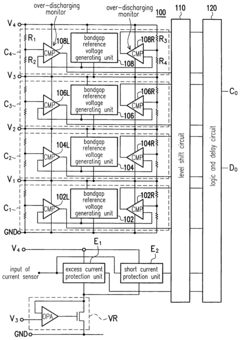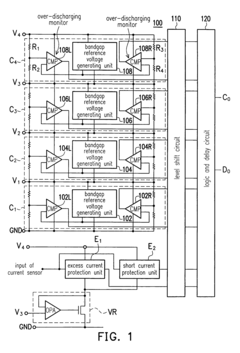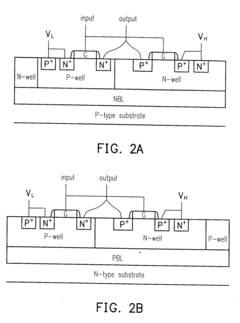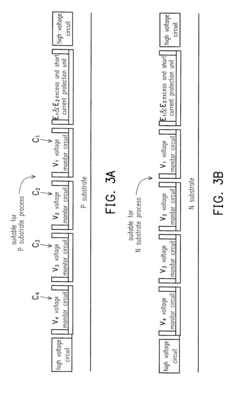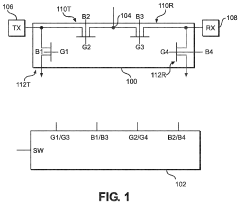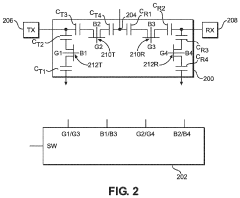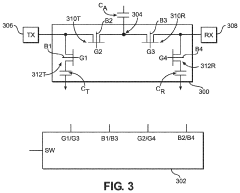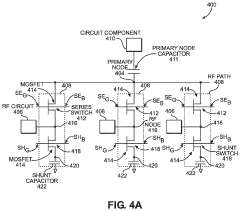How to Select the Best CMOS Battery for Your Device?
JUL 22, 20259 MIN READ
Generate Your Research Report Instantly with AI Agent
Patsnap Eureka helps you evaluate technical feasibility & market potential.
CMOS Battery Overview
CMOS batteries, also known as RTC (Real-Time Clock) batteries, play a crucial role in maintaining system settings and timekeeping functions in various electronic devices. These small, coin-shaped batteries are typically lithium-based and provide a constant power source to the CMOS (Complementary Metal-Oxide-Semiconductor) chip, which stores critical system information.
The primary function of a CMOS battery is to preserve BIOS settings, system time, and date information when the main power source is disconnected. This ensures that devices can maintain accurate timekeeping and retain essential configuration data even when powered off or unplugged for extended periods. CMOS batteries are commonly found in desktop computers, laptops, servers, and other electronic devices that require persistent memory for system settings.
CMOS batteries come in various sizes and capacities, with the most common types being CR2032, CR2025, and CR2016. The numbers in these designations typically represent the battery's dimensions, with the first two digits indicating the diameter in millimeters and the last two digits representing the thickness in tenths of a millimeters. For example, a CR2032 battery has a diameter of 20mm and a thickness of 3.2mm.
When selecting a CMOS battery for a device, several factors must be considered. Compatibility with the device's specifications is paramount, as using an incompatible battery can lead to poor performance or potential damage. Voltage requirements, typically 3 volts for most CMOS batteries, must be met to ensure proper functionality. Additionally, the physical dimensions of the battery should match the device's battery compartment to ensure a secure fit.
Capacity is another crucial factor in CMOS battery selection. Higher capacity batteries generally offer longer lifespans, reducing the frequency of replacements. However, it's essential to balance capacity with size constraints, as some devices may have limited space for the battery. The expected lifespan of a CMOS battery can vary significantly, ranging from 2 to 10 years, depending on factors such as usage patterns, environmental conditions, and the quality of the battery itself.
Environmental considerations also play a role in CMOS battery selection. Devices exposed to extreme temperatures or high humidity may require batteries specifically designed to withstand such conditions. Some manufacturers offer CMOS batteries with enhanced temperature resistance or improved sealing to protect against moisture ingress.
In recent years, advancements in CMOS battery technology have led to the development of rechargeable options and more environmentally friendly alternatives. These innovations aim to address concerns about battery disposal and reduce the need for frequent replacements in high-usage scenarios.
The primary function of a CMOS battery is to preserve BIOS settings, system time, and date information when the main power source is disconnected. This ensures that devices can maintain accurate timekeeping and retain essential configuration data even when powered off or unplugged for extended periods. CMOS batteries are commonly found in desktop computers, laptops, servers, and other electronic devices that require persistent memory for system settings.
CMOS batteries come in various sizes and capacities, with the most common types being CR2032, CR2025, and CR2016. The numbers in these designations typically represent the battery's dimensions, with the first two digits indicating the diameter in millimeters and the last two digits representing the thickness in tenths of a millimeters. For example, a CR2032 battery has a diameter of 20mm and a thickness of 3.2mm.
When selecting a CMOS battery for a device, several factors must be considered. Compatibility with the device's specifications is paramount, as using an incompatible battery can lead to poor performance or potential damage. Voltage requirements, typically 3 volts for most CMOS batteries, must be met to ensure proper functionality. Additionally, the physical dimensions of the battery should match the device's battery compartment to ensure a secure fit.
Capacity is another crucial factor in CMOS battery selection. Higher capacity batteries generally offer longer lifespans, reducing the frequency of replacements. However, it's essential to balance capacity with size constraints, as some devices may have limited space for the battery. The expected lifespan of a CMOS battery can vary significantly, ranging from 2 to 10 years, depending on factors such as usage patterns, environmental conditions, and the quality of the battery itself.
Environmental considerations also play a role in CMOS battery selection. Devices exposed to extreme temperatures or high humidity may require batteries specifically designed to withstand such conditions. Some manufacturers offer CMOS batteries with enhanced temperature resistance or improved sealing to protect against moisture ingress.
In recent years, advancements in CMOS battery technology have led to the development of rechargeable options and more environmentally friendly alternatives. These innovations aim to address concerns about battery disposal and reduce the need for frequent replacements in high-usage scenarios.
Market Demand Analysis
The market demand for CMOS batteries has been steadily growing due to the increasing reliance on electronic devices across various industries. These small but crucial components play a vital role in maintaining system settings and real-time clock functions in a wide range of devices, from personal computers to industrial equipment.
In the consumer electronics sector, the demand for CMOS batteries remains strong, driven by the continuous growth of the personal computer market. Despite the shift towards mobile devices, desktop computers and laptops still require CMOS batteries to maintain BIOS settings and system time. The global PC market, including desktops, notebooks, and workstations, has shown resilience and even growth in recent years, particularly due to the increased demand for remote work and learning solutions.
The enterprise and industrial sectors also contribute significantly to the CMOS battery market. Servers, network equipment, and industrial control systems all rely on CMOS batteries to maintain critical settings and ensure uninterrupted operation. As businesses continue to digitize their operations and invest in IT infrastructure, the demand for reliable CMOS batteries in these sectors is expected to remain strong.
The automotive industry represents another growing market for CMOS batteries. Modern vehicles incorporate increasingly sophisticated electronic systems, many of which require CMOS batteries to maintain settings and data. As the automotive industry moves towards greater electrification and autonomous driving technologies, the demand for CMOS batteries in this sector is projected to increase.
The healthcare sector is emerging as a significant market for CMOS batteries, particularly in medical devices and equipment. From diagnostic tools to patient monitoring systems, many medical devices rely on CMOS batteries to maintain critical settings and data. The growing adoption of electronic health records and telemedicine solutions further drives the demand in this sector.
The Internet of Things (IoT) and smart home devices represent a rapidly expanding market for CMOS batteries. As more household appliances and devices become connected and intelligent, the need for reliable power sources to maintain settings and connectivity increases. This trend is expected to drive significant growth in the CMOS battery market in the coming years.
In terms of market trends, there is a growing demand for longer-lasting and more environmentally friendly CMOS batteries. Manufacturers are focusing on developing batteries with extended lifespans and improved energy density to meet the needs of devices that require long-term reliability. Additionally, there is increasing interest in rechargeable CMOS battery solutions, particularly for applications where frequent battery replacement is impractical or costly.
In the consumer electronics sector, the demand for CMOS batteries remains strong, driven by the continuous growth of the personal computer market. Despite the shift towards mobile devices, desktop computers and laptops still require CMOS batteries to maintain BIOS settings and system time. The global PC market, including desktops, notebooks, and workstations, has shown resilience and even growth in recent years, particularly due to the increased demand for remote work and learning solutions.
The enterprise and industrial sectors also contribute significantly to the CMOS battery market. Servers, network equipment, and industrial control systems all rely on CMOS batteries to maintain critical settings and ensure uninterrupted operation. As businesses continue to digitize their operations and invest in IT infrastructure, the demand for reliable CMOS batteries in these sectors is expected to remain strong.
The automotive industry represents another growing market for CMOS batteries. Modern vehicles incorporate increasingly sophisticated electronic systems, many of which require CMOS batteries to maintain settings and data. As the automotive industry moves towards greater electrification and autonomous driving technologies, the demand for CMOS batteries in this sector is projected to increase.
The healthcare sector is emerging as a significant market for CMOS batteries, particularly in medical devices and equipment. From diagnostic tools to patient monitoring systems, many medical devices rely on CMOS batteries to maintain critical settings and data. The growing adoption of electronic health records and telemedicine solutions further drives the demand in this sector.
The Internet of Things (IoT) and smart home devices represent a rapidly expanding market for CMOS batteries. As more household appliances and devices become connected and intelligent, the need for reliable power sources to maintain settings and connectivity increases. This trend is expected to drive significant growth in the CMOS battery market in the coming years.
In terms of market trends, there is a growing demand for longer-lasting and more environmentally friendly CMOS batteries. Manufacturers are focusing on developing batteries with extended lifespans and improved energy density to meet the needs of devices that require long-term reliability. Additionally, there is increasing interest in rechargeable CMOS battery solutions, particularly for applications where frequent battery replacement is impractical or costly.
Technical Challenges
The selection of an appropriate CMOS battery for a device presents several technical challenges that must be carefully considered. One of the primary challenges is ensuring compatibility with the device's motherboard and BIOS. Different devices may require specific battery types, voltages, and form factors, making it crucial to identify the exact specifications needed for optimal performance.
Another significant challenge is balancing the battery's capacity with its physical size. CMOS batteries are typically small to fit within compact device designs, but this can limit their energy storage capacity. Engineers must carefully evaluate the trade-offs between battery life and space constraints, especially in increasingly miniaturized devices.
Longevity and reliability pose additional challenges in CMOS battery selection. These batteries are expected to maintain the device's critical settings for extended periods, often several years. Ensuring consistent performance over time, even under varying environmental conditions, is essential. Factors such as temperature fluctuations, humidity, and potential exposure to electromagnetic interference can impact battery life and reliability.
The environmental impact of CMOS batteries is an emerging challenge in today's eco-conscious market. Many traditional CMOS batteries contain harmful materials like lithium or mercury, which can pose disposal and recycling issues. Selecting batteries that are both environmentally friendly and capable of meeting performance requirements is becoming increasingly important.
Cost considerations present another challenge in CMOS battery selection. While high-quality batteries may offer better performance and longevity, they often come at a premium price. Balancing cost-effectiveness with performance is crucial, especially for devices produced in large quantities where even small price differences can significantly impact overall production costs.
Compatibility with emerging technologies and future device designs is a forward-looking challenge. As devices evolve, CMOS batteries must adapt to new form factors, power requirements, and integration methods. This necessitates ongoing research and development to create batteries that can meet both current and future needs.
The challenge of power efficiency is also significant. CMOS batteries must provide stable power over long periods while consuming minimal energy. This requires careful design of both the battery and the device's power management systems to ensure optimal energy utilization and minimize unnecessary drain.
Lastly, the manufacturing and quality control of CMOS batteries present their own set of challenges. Ensuring consistent quality across large production runs, maintaining strict tolerances in size and electrical characteristics, and implementing robust testing procedures are all critical aspects of producing reliable CMOS batteries for diverse device applications.
Another significant challenge is balancing the battery's capacity with its physical size. CMOS batteries are typically small to fit within compact device designs, but this can limit their energy storage capacity. Engineers must carefully evaluate the trade-offs between battery life and space constraints, especially in increasingly miniaturized devices.
Longevity and reliability pose additional challenges in CMOS battery selection. These batteries are expected to maintain the device's critical settings for extended periods, often several years. Ensuring consistent performance over time, even under varying environmental conditions, is essential. Factors such as temperature fluctuations, humidity, and potential exposure to electromagnetic interference can impact battery life and reliability.
The environmental impact of CMOS batteries is an emerging challenge in today's eco-conscious market. Many traditional CMOS batteries contain harmful materials like lithium or mercury, which can pose disposal and recycling issues. Selecting batteries that are both environmentally friendly and capable of meeting performance requirements is becoming increasingly important.
Cost considerations present another challenge in CMOS battery selection. While high-quality batteries may offer better performance and longevity, they often come at a premium price. Balancing cost-effectiveness with performance is crucial, especially for devices produced in large quantities where even small price differences can significantly impact overall production costs.
Compatibility with emerging technologies and future device designs is a forward-looking challenge. As devices evolve, CMOS batteries must adapt to new form factors, power requirements, and integration methods. This necessitates ongoing research and development to create batteries that can meet both current and future needs.
The challenge of power efficiency is also significant. CMOS batteries must provide stable power over long periods while consuming minimal energy. This requires careful design of both the battery and the device's power management systems to ensure optimal energy utilization and minimize unnecessary drain.
Lastly, the manufacturing and quality control of CMOS batteries present their own set of challenges. Ensuring consistent quality across large production runs, maintaining strict tolerances in size and electrical characteristics, and implementing robust testing procedures are all critical aspects of producing reliable CMOS batteries for diverse device applications.
Current Selection Criteria
01 Power management for CMOS battery
Techniques for managing power consumption and extending the life of CMOS batteries in electronic devices. This includes implementing power-saving modes, optimizing voltage regulation, and developing efficient charging mechanisms to enhance overall battery performance and longevity.- Power management for CMOS battery: Techniques for managing power consumption and extending the life of CMOS batteries in electronic devices. This includes implementing low-power modes, optimizing voltage regulation, and intelligent power distribution to reduce drain on the battery while maintaining essential functions.
- CMOS battery monitoring and replacement indication: Systems and methods for monitoring CMOS battery health, predicting battery life, and providing timely indications for replacement. This involves measuring battery voltage, tracking usage patterns, and implementing warning systems to prevent data loss due to battery failure.
- CMOS circuit design for improved battery performance: Innovative circuit designs and architectures that enhance CMOS battery performance. This includes low-leakage transistor configurations, adaptive biasing techniques, and optimized layout strategies to minimize power consumption in CMOS devices.
- Integration of alternative power sources with CMOS battery: Methods for integrating supplementary power sources, such as capacitors or energy harvesting systems, with CMOS batteries. This approach aims to reduce the load on the primary battery, extend its life, and provide backup power during battery replacement.
- Temperature compensation for CMOS battery performance: Techniques for maintaining optimal CMOS battery performance across various temperature ranges. This includes implementing temperature-sensitive charging algorithms, thermal management systems, and adaptive voltage regulation to ensure consistent battery operation in different environmental conditions.
02 CMOS battery monitoring and replacement
Systems and methods for monitoring CMOS battery health, detecting low battery conditions, and facilitating timely replacement. This involves implementing battery status indicators, automated alerts, and user-friendly replacement procedures to ensure continuous operation of CMOS-dependent functions.Expand Specific Solutions03 CMOS circuit design for improved battery efficiency
Innovative circuit designs and architectures that minimize power draw from CMOS batteries. This includes developing low-power CMOS configurations, implementing power gating techniques, and optimizing clock distribution to reduce overall energy consumption and extend battery life.Expand Specific Solutions04 Integration of alternative power sources with CMOS batteries
Approaches for incorporating supplementary power sources to complement or reduce reliance on traditional CMOS batteries. This may involve integrating energy harvesting technologies, implementing hybrid power systems, or developing novel energy storage solutions to enhance overall system reliability and longevity.Expand Specific Solutions05 Advanced materials and manufacturing for CMOS batteries
Development of new materials and manufacturing processes to enhance CMOS battery performance. This includes exploring novel electrode materials, electrolyte compositions, and fabrication techniques to improve energy density, charge retention, and overall battery efficiency in CMOS applications.Expand Specific Solutions
Key Manufacturers
The CMOS battery selection landscape is characterized by a mature market with established players and standardized technologies. The global market for CMOS batteries is relatively stable, with moderate growth driven by the continuous demand for electronic devices. Key players like Samsung SDI, Sony Group, and Panasonic dominate the market, leveraging their extensive manufacturing capabilities and research expertise. The technology is well-established, with incremental improvements focusing on longevity, size reduction, and environmental sustainability. Emerging trends include the development of rechargeable CMOS batteries and integration with energy harvesting technologies, potentially opening new opportunities for innovation and market expansion.
Samsung SDI Co., Ltd.
Technical Solution: Samsung SDI has developed advanced CMOS battery technologies for various devices. Their approach focuses on lithium-ion coin cell batteries, which offer higher energy density and longer lifespan compared to traditional CR2032 batteries[1]. Samsung's CMOS batteries feature low self-discharge rates, typically less than 1% per year, ensuring long-term reliability for device memory backup[3]. They have also implemented safety features such as built-in protection circuits to prevent overcharging and short circuits[5]. Samsung's CMOS batteries are designed to operate in a wide temperature range, from -20°C to 60°C, making them suitable for diverse applications[2].
Strengths: High energy density, long lifespan, low self-discharge rate, and wide temperature range operation. Weaknesses: Potentially higher cost compared to standard CR2032 batteries, and may require specific charging circuits.
Dell Products LP
Technical Solution: Dell has developed a comprehensive approach to CMOS battery selection and management for their computer systems. They utilize smart battery selection algorithms that consider factors such as device power requirements, expected lifespan, and environmental conditions[8]. Dell's CMOS batteries are often custom-designed to fit their specific laptop and desktop models, ensuring optimal performance and longevity. They have also implemented battery health monitoring systems that can alert users when CMOS battery replacement is necessary, preventing unexpected data loss[9]. Dell's CMOS batteries typically use lithium manganese dioxide chemistry, offering a good balance between cost and performance[10].
Strengths: Custom-designed batteries for specific models, smart battery selection algorithms, and battery health monitoring. Weaknesses: Proprietary designs may limit third-party replacement options.
Innovative Battery Tech
Complementary metal oxide semiconductor structure for battery protection circuit and battery protection circuit having the same
PatentInactiveUS20050052802A1
Innovation
- The implementation of a CMOS structure using tri-well or buried layer techniques allows for a battery protection circuit that operates at relatively low voltage, isolates substrate noise, and includes overcharging and over-discharging units, excess current protection, and short circuit protection, utilizing NMOS and PMOS transistors with specific voltage configurations and a bandgap reference voltage-generating unit to monitor and regulate battery voltage and current.
Complementary metal-oxide semiconductor (CMOS) compatible RF switch and high voltage control circuit (HVCC)
PatentActiveUS20210050846A1
Innovation
- A CMOS-compatible RF switch circuit with a high voltage control circuit (HVCC) that uses standard CMOS logic circuits to supply high and low voltage signals to MOSFET switches, eliminating the need for charge pumps and capacitors by employing a medial voltage between the power supply and reference voltage to fully turn on and off the switches.
Environmental Impact
The environmental impact of CMOS batteries is an important consideration when selecting the best option for your device. These small but essential components contribute to electronic waste and can have significant ecological implications if not properly managed.
CMOS batteries typically contain lithium, a reactive metal that can be harmful to the environment if not disposed of correctly. When these batteries end up in landfills, they can leak toxic substances into the soil and groundwater, potentially causing long-term ecological damage. Additionally, the mining and processing of lithium for battery production have their own environmental consequences, including water pollution and habitat destruction.
To mitigate these environmental concerns, many manufacturers are now focusing on developing more eco-friendly CMOS battery options. Some are exploring the use of alternative materials that have less environmental impact, such as zinc-air or silver-oxide batteries. These alternatives may offer comparable performance while reducing the ecological footprint associated with lithium-based batteries.
Recyclability is another crucial factor in assessing the environmental impact of CMOS batteries. Many regions now have dedicated recycling programs for electronic components, including batteries. When selecting a CMOS battery, it's important to consider whether the manufacturer has established recycling initiatives or partnerships with recycling facilities. Batteries that are easily recyclable can significantly reduce their overall environmental impact.
The lifespan of the CMOS battery also plays a role in its environmental impact. Longer-lasting batteries reduce the frequency of replacement, thereby decreasing the overall number of batteries entering the waste stream. When evaluating CMOS battery options, it's beneficial to consider those with extended lifespans, as they can contribute to a reduction in electronic waste over time.
Energy efficiency is another aspect to consider when assessing the environmental impact of CMOS batteries. More efficient batteries require less frequent charging or replacement, which can lead to reduced energy consumption over the device's lifetime. This efficiency not only extends the battery's usable life but also contributes to lower overall energy demands and, consequently, a reduced carbon footprint.
Packaging and transportation also factor into the environmental impact of CMOS batteries. Batteries that are packaged in recyclable or biodegradable materials and shipped using eco-friendly methods can further reduce their ecological footprint. When selecting a CMOS battery, it's worth considering manufacturers who prioritize sustainable packaging and distribution practices.
In conclusion, the environmental impact of CMOS batteries is a multifaceted issue that encompasses production, use, and disposal. By considering factors such as materials, recyclability, lifespan, energy efficiency, and packaging, device manufacturers and consumers can make more informed decisions that minimize the ecological consequences of these essential components.
CMOS batteries typically contain lithium, a reactive metal that can be harmful to the environment if not disposed of correctly. When these batteries end up in landfills, they can leak toxic substances into the soil and groundwater, potentially causing long-term ecological damage. Additionally, the mining and processing of lithium for battery production have their own environmental consequences, including water pollution and habitat destruction.
To mitigate these environmental concerns, many manufacturers are now focusing on developing more eco-friendly CMOS battery options. Some are exploring the use of alternative materials that have less environmental impact, such as zinc-air or silver-oxide batteries. These alternatives may offer comparable performance while reducing the ecological footprint associated with lithium-based batteries.
Recyclability is another crucial factor in assessing the environmental impact of CMOS batteries. Many regions now have dedicated recycling programs for electronic components, including batteries. When selecting a CMOS battery, it's important to consider whether the manufacturer has established recycling initiatives or partnerships with recycling facilities. Batteries that are easily recyclable can significantly reduce their overall environmental impact.
The lifespan of the CMOS battery also plays a role in its environmental impact. Longer-lasting batteries reduce the frequency of replacement, thereby decreasing the overall number of batteries entering the waste stream. When evaluating CMOS battery options, it's beneficial to consider those with extended lifespans, as they can contribute to a reduction in electronic waste over time.
Energy efficiency is another aspect to consider when assessing the environmental impact of CMOS batteries. More efficient batteries require less frequent charging or replacement, which can lead to reduced energy consumption over the device's lifetime. This efficiency not only extends the battery's usable life but also contributes to lower overall energy demands and, consequently, a reduced carbon footprint.
Packaging and transportation also factor into the environmental impact of CMOS batteries. Batteries that are packaged in recyclable or biodegradable materials and shipped using eco-friendly methods can further reduce their ecological footprint. When selecting a CMOS battery, it's worth considering manufacturers who prioritize sustainable packaging and distribution practices.
In conclusion, the environmental impact of CMOS batteries is a multifaceted issue that encompasses production, use, and disposal. By considering factors such as materials, recyclability, lifespan, energy efficiency, and packaging, device manufacturers and consumers can make more informed decisions that minimize the ecological consequences of these essential components.
Device Compatibility
When selecting the best CMOS battery for your device, device compatibility is a crucial factor to consider. Different devices have varying requirements for CMOS batteries, and choosing the right one ensures optimal performance and longevity. The first step in determining compatibility is to identify the specific model and make of your device. This information can typically be found in the device's manual or by consulting the manufacturer's website.
Once you have identified your device, research the recommended CMOS battery specifications. Pay close attention to the voltage requirements, as most devices use either 3V or 3.6V batteries. Using a battery with the wrong voltage can lead to device malfunction or damage. Additionally, consider the physical dimensions of the battery compartment in your device. CMOS batteries come in various sizes, with common types including CR2032, CR2025, and CR2016. Ensure that the battery you choose fits snugly in the designated space without any modifications.
Compatibility also extends to the battery's chemistry. Lithium-based batteries are the most common for CMOS applications due to their long shelf life and stable voltage output. However, some older devices may require silver oxide batteries. Always verify the recommended chemistry for your specific device to avoid potential issues.
Another important aspect of device compatibility is the battery's capacity, measured in milliamp-hours (mAh). Higher capacity batteries generally last longer, but they may not always be suitable for all devices. Some devices are designed to work with specific capacity ranges, so it's essential to check if there are any limitations or recommendations regarding battery capacity for your particular model.
Consider the operating temperature range of both your device and the CMOS battery. If your device is used in extreme environments, such as industrial settings or outdoor installations, ensure that the chosen battery can withstand the temperature fluctuations without compromising performance or safety.
Lastly, take into account any special features or requirements of your device. Some devices may need batteries with specific terminals or connectors, while others might require batteries with built-in protection circuits. By carefully considering all these factors, you can select a CMOS battery that is fully compatible with your device, ensuring reliable operation and extended service life.
Once you have identified your device, research the recommended CMOS battery specifications. Pay close attention to the voltage requirements, as most devices use either 3V or 3.6V batteries. Using a battery with the wrong voltage can lead to device malfunction or damage. Additionally, consider the physical dimensions of the battery compartment in your device. CMOS batteries come in various sizes, with common types including CR2032, CR2025, and CR2016. Ensure that the battery you choose fits snugly in the designated space without any modifications.
Compatibility also extends to the battery's chemistry. Lithium-based batteries are the most common for CMOS applications due to their long shelf life and stable voltage output. However, some older devices may require silver oxide batteries. Always verify the recommended chemistry for your specific device to avoid potential issues.
Another important aspect of device compatibility is the battery's capacity, measured in milliamp-hours (mAh). Higher capacity batteries generally last longer, but they may not always be suitable for all devices. Some devices are designed to work with specific capacity ranges, so it's essential to check if there are any limitations or recommendations regarding battery capacity for your particular model.
Consider the operating temperature range of both your device and the CMOS battery. If your device is used in extreme environments, such as industrial settings or outdoor installations, ensure that the chosen battery can withstand the temperature fluctuations without compromising performance or safety.
Lastly, take into account any special features or requirements of your device. Some devices may need batteries with specific terminals or connectors, while others might require batteries with built-in protection circuits. By carefully considering all these factors, you can select a CMOS battery that is fully compatible with your device, ensuring reliable operation and extended service life.
Unlock deeper insights with Patsnap Eureka Quick Research — get a full tech report to explore trends and direct your research. Try now!
Generate Your Research Report Instantly with AI Agent
Supercharge your innovation with Patsnap Eureka AI Agent Platform!
